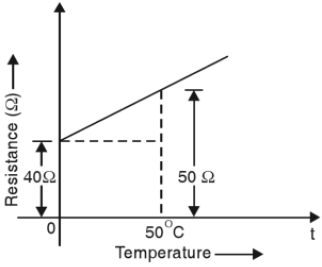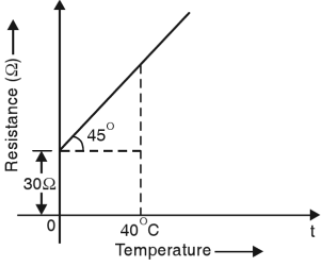41. The example of non-ohmic resistance is
(i) copper wire
(ii) carbon resistance
(iii) aluminium wire
(iv) tungsten wire.
Answer: (ii) carbon resistance
42. A copper wire is stretched so that its length is increased by 0.1%. The change in its resistance is
(i) 0.3%
(ii) 0.4%
(iii) 0.2%
(iv) none of the above.
Answer: (iii) 0.2%
43. If an electric current is passed through a nerve, the man
(i) begins to laugh
(ii) begins to weep
(iii) is excited
(iv) becomes insensitive to pain.
Answer: (ii) begins to weep
44. Which one of the following is the best conductor of electricity ?
(i) silver
(ii) gold
(iii) copper
(iv) zinc.
Answer: (i) silver
45. The temperature co-efficient of resistance of a wire is 0.00125 per °C. At 300 K, its resistance is 1Ω. The resistance of the wire will be 2Ω at
(i) 1154K
(ii) 1100K
(iii) 1400K
(iv) 1127K
Answer: (ii) 1100K
46. Ampere – hour is the unit of
(i) quantity of electricity
(ii) strength of current
(iii) power
(iv) energy.
Answer: (i) quantity of electricity
47. The resistance of a conductor is 5 Ω at 50°C and 6 Ω at 100°C. What is its resistance at 0°C ?
(i) 1 Ω
(ii) 2 Ω
(iii) 3 Ω
(iv) 4 Ω
Answer: (iv) 4 Ω
48. Fig. 1.16 shows the temperature/resistance graph of a conductor. The value of αo is
(i) 0.005/°C
(ii) 0.04/oC
(iii) 0.1/oC
(iv) 0.4/°C
Answer: (i) 0.005/°C

49. Referring to the above Fig.1, the value of α50 will
be ..
(i) 0.005/oC
(ii) 0.004/oC
(iii) 0.4/oC
(iv) 0.05/oC
Answer: (ii) 0.004/oC

50. Referring to Fig. 2, the value of αo is
(i) 1/30 per °C
(ii) 1/40 per °C
(iii) 1/1200 per °C
(iv) none of the above
Answer: (i) 1/30 per °C
51. Referring to Fig. 2, the value of R40 will be
(i) 70 Ω
(ii) 40 Ω
(iii) 35 Ω
(iv) 50 Ω
Answer: (i) 70 Ω
52. Referring to Fig. 2, the value of α40 will be
(i) 1/30 per °C
(ii) 1/70 per °C
(iii) 1/50 per°C
(iv) 1/1200 per °C
Answer: (ii) 1/70 per °C
53. The value of αo of a conductor is 1/236 per °C. The value of α18 will be
(i) 1/218 per °C
(ii) 1/272 per °C
(iii) 1/254 per °C
(iv) none of the above
Answer: (iii) 1/254 per °C
54. The value of α25 of a conductor is 1/255 per °C. The value of α20 will be
(i) 1/300 per °C
(ii) 1/230 per °C
(iii) 1/250 per °C
(iv) 1/265 per °C
Answer: (iii) 1/250 per °C
55. The value of α50 of a conductor is 1/230 per °C. The value of αo will be
(i) 1/180 per °C
(ii) 1/280 per °C
(iii) 1/250 per °C
(iv) none of the above
Answer: (i) 1/180 per °C
56. The number of free electrons passing through the filament of an electric lamp in one hour when the current through the filament is 0.32 A will be
(i) 3 x 1022
(ii) 2 x 1026
(iii) 7.2 x 1019
(iv) 7.2 x 1021.
Answer: (iv) 7.2 x 1021.
57. In which of the following substances the resistance decreases with increase in temperature?
(i) carbon
(ii) constantan
(iii) copper
(iv) silver
Answer: (i) carbon
58. A wire having very high value of conductance is said to be
(i) very good conductor
(ii) moderately good conductor
(iii) insulator
(iv) none of the above
Answer: (i) very good conductor
59. An electric heater is marked 2000 W, 200 V. The resistance of the coil is
(i) 0.1 Ω
(ii) 20 Ω
(iii) 1/20 Ω
(iv) 200 Ω
Answer: (ii) 20 Ω
60. The current in a circuit having constant resistance is tripled. The power increases
(i) 1/9 times
(ii) 3 times
(iii) 9 times
(iv) 1/3 times